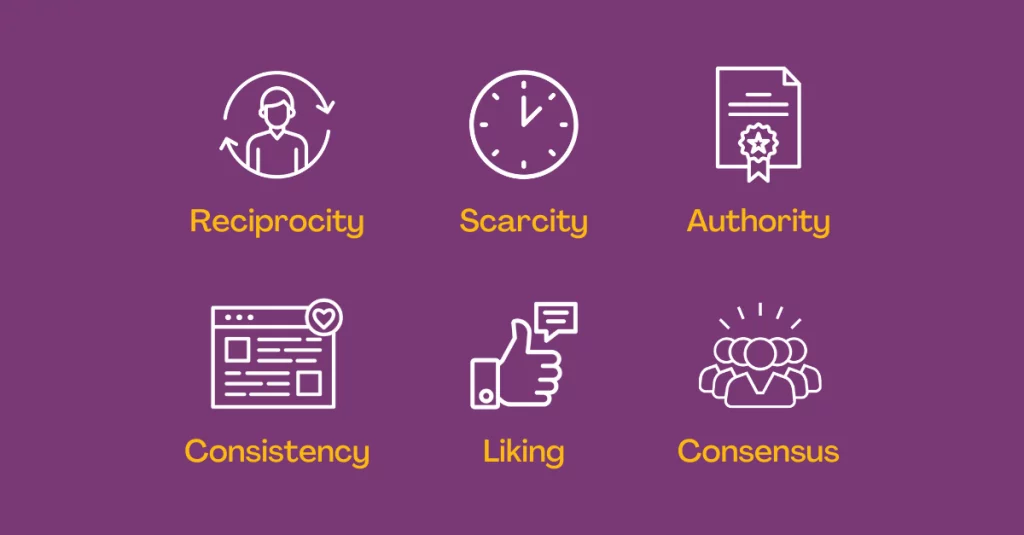The psychologist Robert B. Cialdini has written what many marketers consider the go-to book when it comes to persuading potential customers. In his book ‘Influence’ he lists the 6 principles of persuasion that form the basis of any advertising or marketing campaign. But how can you implement these 6 principles to create more conversions on your website?
Cialdini's 6 principles of persuasion
1. Authority
Several studies show that people are sensitive to authority and expertise, this also means that customers will be more likely to accept advice from a specialist. But how can you convey this authority to your target audience?
Take advantage of the fact that you have more knowledge than anyone else in your field: show that you are an expert in your field showcasing your well-earned titles and achieved results. The website must also express authority in terms of design and content to gain the trust of your visitor. This can be reinforced by using familiar logos of well-known payment methods or certification marks.
You can also use the authority of someone else. Celebrities or well-known specialists in a field can be more influential to customers. Look into these possibilities to elevate your brand.
2. Consistency
According to Cialdini, you are already creating a bond with a customer after they take a small step within the customer journey, encouraging commitment on their part. These customers are also more likely to commit to a larger step such as a purchase. This is because people like consistency, as inconsistency is often perceived as a negative trait that people do not want to associate with.
Research shows that customers need an average of 7 contacts to proceed with a purchase, so keep that in mind when planning content. Look into the possibilities of using social media channels or writing a monthly newsletter. This way, you will be getting closer to conversion with every step.
Make sure customers get into a ‘YES-flow’ to trigger consistency: ask easy questions first and/or use an opt-in 2 times, first without and then with a fill-in field.
3. Scarcity
‘Running out of stock’ and ‘Limited number available’ are common marketing terms that we encounter often as consumers. The principle of scarcity is applied here. The use of this principle can also help us to achieve more conversions online. This powerful and effective method ensures that hesitant visitors have to make a quick choice.
Make use of a limited offer that forces visitors to make quick decisions. Communicate this in clear language and striking colors on the website. By mentioning that multiple people are looking at a product, you make it clear that there are multiple potential suitors looking to buy it. In order not to scare away visitors, you can also offer a reservation (for a fee) for a certain amount of time. Time pressure is a good way to give consumers the feeling they have to decide quickly.
4. Consensus
‘If they do it, I will do it too!’: people assume that if someone makes a decision, it will be the right one. We especially tend to think this way with people we can identify with and when we are unsure about what to choose. Consensus is therefore a powerful weapon to generate more conversions.
Display your top-5 most purchased products/services on your website. Rankings always work well, as it makes potential customers feel more in line with the trend!
Showcase your community on social media. If so many people like it it must be good right?
Offer the opportunity to leave reviews or ratings. This allows customers to read the opinions of others who were previously in the same situation. Add options such as age, function, and place of residence according to what could be relevant
And finally, odd numbers work better than even numbers. Suppose you have 20 tips about SEO: make it 19 and a bonus one!
5. Liking
We prefer to purchase a product or service from businesses we like. The likability of a brand often comes from previous experiences, resemblances, or attractiveness, as these contribute to the customer’s perception of the brand. So ask yourself the question ‘How likable is my brand?’
Create an attractive ‘about us’ page to generate sympathy among your visitors. Do this by making it personal and reinforcing it with visuals. Be transparent, speak the language of your target group, and create a friendly character on the website that suits your target group. Choose a charity that is easily identifiable with your company. All these steps will elevate the storytelling of your brand and increase your likability with your customers.
6. Reciprocity
When people do something for us, we soon have the tendency to want to do something in return. This falls under the persuasion principle of reciprocity. For this reason, it is a good idea to give a small gift to your potential customers. This gift should be unexpected, personal, and meaningful: give away information, a sample, or a discount code to elicit a response.
Give away relevant content that can be useful to your target audience. Place this on your website in the form of white papers, informative videos, tips, or infographics. In exchange, ask for their data. A nice deal right?
Another good idea is to give away trials, testers, discounts, or a free month on a subscription. This way you will leave a good impression and surprise your customers, binding them to your brand to ultimately generate conversions!
Now that the 6 principles of persuasion are clear...
It’s time to put them into practice! Think carefully about which principles of persuasion fit your product or service best. Not every principle has to be relevant to every campaign. Do you have questions about how to take the online marketing of your IT business to the next level? Get in touch with us through the button below.





